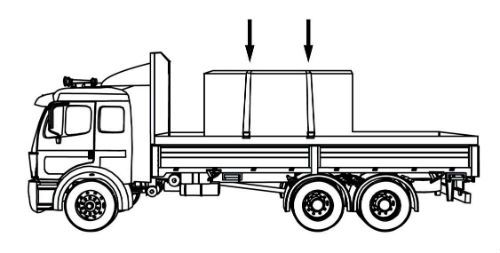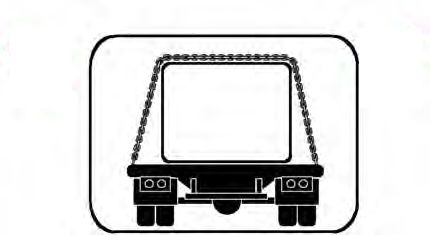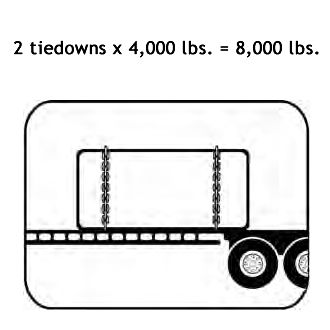Note: Your are not logged in. We can not keep your scores or track your progress unless you Register and Log In
The Purpose of Indirect Tie-downs

The purpose of the indirect tie-down is to increase the pressure of the article on the deck (that is, to increase the frictional force between the article and the deck).
An indirect tie-down has failed if the article shifts. If friction is low between the deck and the cargo (such as a plastic skid, plastic-coated article, or an oilsoaked/ wet deck), direct tie-downs can be more effective. Under these conditions, consider using friction mats or other friction enhancing devices.

An indirect tie-down that is used to prevent front-to-back cargo movement must make an angle of at least 30 degrees with the deck when viewed from the side of the vehicle.

An indirect tie-down that is used to prevent side-to-side movement must make an angle of at least 30 degrees when viewed from the front or back of the vehicle.
An indirect tie-down should be tensioned to as high an initial tension as possible, at least 50% of its working load limit. The tension should be maintained throughout the trip.
Calculating Working Load Limits for Indirect Tie-downs:
Each tie-down that passes over an article is considered to be 1 tie-down.

The aggregate working load limit of all indirect tie-downs is the sum of the working load limits of each indirect tie-down.
In this picture, if each tie-down has a working load limit of 4,000 lbs. (1,820 kgs.), the aggregate working load limit for this securement system is 8,000 lbs. (3,640 kgs.).
 Cargo Securement Terms That Truck Drivers Should Know:
Cargo Securement Terms That Truck Drivers Should Know:
-
Intermodal Container:
A reusable, transportable enclosure that is especially designed with integral locking devices that secure it to a container chassis trailer to facilitate the efficient and bulk shipping and transfer of goods by, or between various modes of transport, such as highway, rail, sea, and air.
-
Bulkhead:
A vertical barrier across a vehicle to prevent forward movement of cargo.
-
Hook-lift Container:
A specialized container, primarily used to contain and transport materials in the waste, recycling, construction/demolition, and scrap industries, which are used in conjunction with specialized vehicles, in which the container isloaded and unloaded onto a tilt frame body by an articulating hook-arm.
-
Well:
The depression formed between two cylindrical articles when they are laid with their eyes horizontal and parallel against each other.
Multiple-Choice Questions:
A 'hook-lift container' is:
- A reusable, transportable enclosure that is especially designed with integral locking devices that secure it to a container chassis trailer to facilitate the efficient and bulk shipping and transfer of goods by, or between various modes of transport, such as highway, rail, sea, and air.
- A vehicle especially built and fitted with locking devices for the transport of intermodal containers.
- A specialized container, primarily used to contain and transport materials in the waste, recycling, construction/demolition, and scrap industries, which are used in conjunction with specialized vehicles, in which the container isloaded and unloaded onto a tilt frame body by an articulating hook-arm.
- A platform or tray on which cargo is placed so that it can be handled as an article. (Same as "Skid")
Hook-lift Container:
A specialized container, primarily used to contain and transport materials in the waste, recycling, construction/demolition, and scrap industries, which are used in conjunction with specialized vehicles, in which the container isloaded and unloaded onto a tilt frame body by an articulating hook-arm.
What is the aggregate WLL of two indirect tiedowns with a WLL of 5,000 lbs, and one tiedown with a WLL of 6,000 lbs?
- 5,000 lbs.
- 10,000 lbs.
- 8,000 lbs.
- 16,000 lbs.
The aggregate working load limit of all indirect tiedowns is the sum of the working load limits of each indirect tiedown.
What is the minimum angle that indirect tiedowns must form with the vehicle?
- 180 degrees.
- 30 degrees.
- 45 degrees.
- 90 degrees.

An indirect tiedown that is used to prevent front-to-back cargo movement must make an angle of at least 30 degrees with the deck when viewed from the side of the vehicle.

An indirect tiedown that is used to prevent side-to-side movement must make an angle of at least 30 degrees when viewed from the front or back of the vehicle.
A bulkhead is used:
- to prevent forward movement of cargo.
- to reinforce blocking.
- to protect the cab in the event cargo should shift forward.
- to unitize articles and is tensioned and clamped or crimped back upon itself. (same as "Strapping")
Bulkhead:
A vertical barrier across a vehicle to prevent forward movement of cargo.
In cargo securement, a 'well' is defined as:
- A female housing fixed to the side or ends of a vehicle to receive a stake or peg, and may also be used as an anchor point.
- A vertical barrier across a vehicle to prevent forward movement of cargo.
- A vertical barrier across the front of the deck of a vehicle to prevent forward movement of cargo.
- The depression formed between two cylindrical articles when they are laid with their eyes horizontal and parallel against each other.
Well:
The depression formed between two cylindrical articles when they are laid with their eyes horizontal and parallel against each other.
What is a reusable, transportable enclosure that is especially designed with integral locking devices that secure it to a container chassis trailer to facilitate the efficient and bulk shipping and transfer of goods by, or between various modes of transport, such as highway, rail, sea, and air.?
- Container chassis vehicle.
- Pallet.
- Hook-lift container.
- Intermodal container.
Intermodal Container:
A reusable, transportable enclosure that is especially designed with integral locking devices that secure it to a container chassis trailer to facilitate the efficient and bulk shipping and transfer of goods by, or between various modes of transport, such as highway, rail, sea, and air.
Complete!
You can Return To The Table Of Contents







 TT On Facebook
TT On Facebook